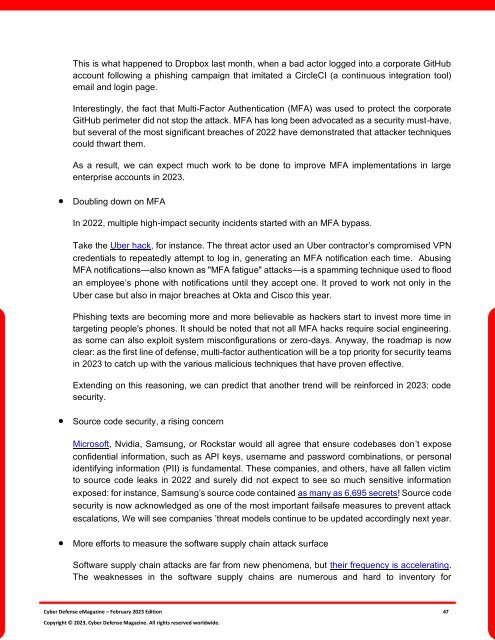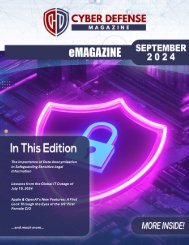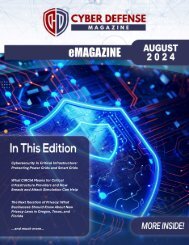Cyber Defense eMagazine February Edition for 2023
Cyber Defense eMagazine February Edition for 2023 #CDM #CYBERDEFENSEMAG @CyberDefenseMag by @Miliefsky a world-renowned cyber security expert and the Publisher of Cyber Defense Magazine as part of the Cyber Defense Media Group as well as Yan Ross, Editor-in-Chief and many more writers, partners and supporters who make this an awesome publication! Thank you all and to our readers! OSINT ROCKS! #CDM #CDMG #OSINT #CYBERSECURITY #INFOSEC #BEST #PRACTICES #TIPS #TECHNIQUES
Cyber Defense eMagazine February Edition for 2023 #CDM #CYBERDEFENSEMAG @CyberDefenseMag by @Miliefsky a world-renowned cyber security expert and the Publisher of Cyber Defense Magazine as part of the Cyber Defense Media Group as well as Yan Ross, Editor-in-Chief and many more writers, partners and supporters who make this an awesome publication! Thank you all and to our readers! OSINT ROCKS! #CDM #CDMG #OSINT #CYBERSECURITY #INFOSEC #BEST #PRACTICES #TIPS #TECHNIQUES
You also want an ePaper? Increase the reach of your titles
YUMPU automatically turns print PDFs into web optimized ePapers that Google loves.
This is what happened to Dropbox last month, when a bad actor logged into a corporate GitHub<br />
account following a phishing campaign that imitated a CircleCI (a continuous integration tool)<br />
email and login page.<br />
Interestingly, the fact that Multi-Factor Authentication (MFA) was used to protect the corporate<br />
GitHub perimeter did not stop the attack. MFA has long been advocated as a security must-have,<br />
but several of the most significant breaches of 2022 have demonstrated that attacker techniques<br />
could thwart them.<br />
As a result, we can expect much work to be done to improve MFA implementations in large<br />
enterprise accounts in <strong>2023</strong>.<br />
●<br />
Doubling down on MFA<br />
In 2022, multiple high-impact security incidents started with an MFA bypass.<br />
Take the Uber hack, <strong>for</strong> instance. The threat actor used an Uber contractor’s compromised VPN<br />
credentials to repeatedly attempt to log in, generating an MFA notification each time. Abusing<br />
MFA notifications—also known as "MFA fatigue" attacks—is a spamming technique used to flood<br />
an employee’s phone with notifications until they accept one. It proved to work not only in the<br />
Uber case but also in major breaches at Okta and Cisco this year.<br />
Phishing texts are becoming more and more believable as hackers start to invest more time in<br />
targeting people's phones. It should be noted that not all MFA hacks require social engineering.<br />
as some can also exploit system misconfigurations or zero-days. Anyway, the roadmap is now<br />
clear: as the first line of defense, multi-factor authentication will be a top priority <strong>for</strong> security teams<br />
in <strong>2023</strong> to catch up with the various malicious techniques that have proven effective.<br />
Extending on this reasoning, we can predict that another trend will be rein<strong>for</strong>ced in <strong>2023</strong>: code<br />
security.<br />
●<br />
Source code security, a rising concern<br />
Microsoft, Nvidia, Samsung, or Rockstar would all agree that ensure codebases don’t expose<br />
confidential in<strong>for</strong>mation, such as API keys, username and password combinations, or personal<br />
identifying in<strong>for</strong>mation (PII) is fundamental. These companies, and others, have all fallen victim<br />
to source code leaks in 2022 and surely did not expect to see so much sensitive in<strong>for</strong>mation<br />
exposed: <strong>for</strong> instance, Samsung’s source code contained as many as 6,695 secrets! Source code<br />
security is now acknowledged as one of the most important failsafe measures to prevent attack<br />
escalations, We will see companies ’threat models continue to be updated accordingly next year.<br />
●<br />
More ef<strong>for</strong>ts to measure the software supply chain attack surface<br />
Software supply chain attacks are far from new phenomena, but their frequency is accelerating.<br />
The weaknesses in the software supply chains are numerous and hard to inventory <strong>for</strong><br />
<strong>Cyber</strong> <strong>Defense</strong> <strong>eMagazine</strong> – <strong>February</strong> <strong>2023</strong> <strong>Edition</strong> 47<br />
Copyright © <strong>2023</strong>, <strong>Cyber</strong> <strong>Defense</strong> Magazine. All rights reserved worldwide.


















